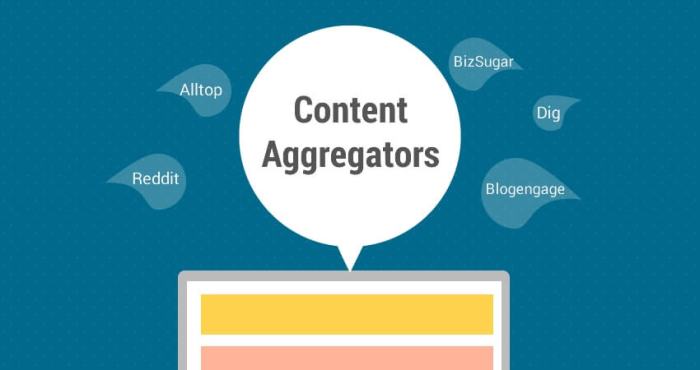Using Content Aggregation Tools opens up a world of possibilities for businesses looking to streamline their online content. From automated to manual tools, the landscape is diverse and exciting. Let’s dive in and explore how these tools can revolutionize your digital strategy.
Introduction to Content Aggregation Tools

Content aggregation tools are software applications that gather and display content from multiple online sources in one centralized location. These tools use algorithms to collect, organize, and present information based on user preferences and settings.
Benefits of Using Content Aggregation Tools for Businesses
- Efficient Content Curation: Businesses can easily curate relevant content from various sources without the need to manually search for information.
- Time-Saving: Content aggregation tools help save time by providing a streamlined process for monitoring industry trends, competitors, and customer feedback.
- Improved Content Marketing: By accessing a variety of content in one place, businesses can enhance their content marketing strategies and create more engaging material for their audience.
- Enhanced Competitive Intelligence: These tools enable businesses to stay informed about their competitors’ activities, helping them make informed decisions and stay ahead in the market.
Popular Content Aggregation Tools in the Market
- Feedly: A popular RSS feed reader that allows users to subscribe to their favorite websites and blogs to stay updated on the latest content.
- Flipboard: An app that aggregates news and articles from various sources, presenting them in a visually appealing magazine-style format.
- Pocket: A content curation tool that lets users save articles, videos, and web pages to read later, even offline.
- Google News: A news aggregator service that provides personalized news based on user preferences and browsing history.
Types of Content Aggregation Tools

When it comes to content aggregation tools, there are various types available in the market that cater to different needs and preferences. Let’s dive into the details of the types of content aggregation tools to help you understand their functionalities and differences.
Automated vs. Manual Content Aggregation Tools
Automated content aggregation tools rely on algorithms to gather and organize content from various sources automatically. These tools can save time and effort by streamlining the process of content curation. On the other hand, manual content aggregation tools require human intervention to select, curate, and organize content. While manual tools offer more control and customization, they can be more time-consuming.
Social Media Aggregators vs. News Aggregators
Social media aggregators focus on gathering content specifically from social media platforms such as Facebook, Twitter, and Instagram. These tools allow users to monitor and manage social media content efficiently. On the other hand, news aggregators specialize in curating news articles and updates from multiple news sources. They provide a centralized platform for users to stay informed about current events and trends.
Free vs. Paid Content Aggregation Tools
Free content aggregation tools typically offer basic features such as content curation and organization. They are suitable for individuals or small businesses with limited budgets. In contrast, paid content aggregation tools come with advanced functionalities such as analytics, customization options, and integration with other tools. These tools are ideal for businesses that require in-depth content management and analysis capabilities.
Best Practices for Using Content Aggregation Tools
When it comes to utilizing content aggregation tools, there are several best practices to keep in mind to ensure effective curation, credibility, and organization of content.
Tips for Effectively Curating Content
- Define your target audience and their interests to curate relevant content.
- Regularly update your content to keep it fresh and engaging for your audience.
- Use a mix of sources to provide diverse perspectives on the topics you cover.
Importance of Verifying Source Credibility
- Always check the credibility of the sources you aggregate content from to maintain trust with your audience.
- Avoid sharing content from unreliable or questionable sources to prevent spreading misinformation.
- Verify the accuracy of information before sharing it to ensure you are providing valuable and trustworthy content.
Strategies for Organizing and Categorizing Content
- Use tags or s to categorize content for easy navigation and searchability.
- Create themed collections or playlists to group related content together for a more organized presentation.
- Regularly review and update your content categories to reflect the latest trends and interests of your audience.
Legal and Ethical Considerations: Using Content Aggregation Tools
When using content aggregation tools, it’s crucial to be aware of the legal and ethical considerations involved. This includes understanding potential copyright issues, giving credit to original sources, and maintaining ethical practices throughout the curation process.
Copyright Issues and Solutions
- Aggregating content from various sources may raise copyright concerns, as you are compiling information created by others.
- To address this, ensure that you have the right to use the content by checking for any copyright permissions or licenses provided by the original sources.
- If necessary, reach out to content creators to request permission or seek alternative content that is available for aggregation.
Importance of Giving Credit, Using Content Aggregation Tools
- It is essential to give credit to the original sources of the content you aggregate, as this acknowledges the creators’ work and respects their intellectual property rights.
- Include proper attribution by citing the source of the content, such as the author’s name, publication date, and website link, to provide transparency to your audience.
- Failure to give credit can lead to plagiarism issues and damage your credibility as a content curator.
Maintaining Ethical Practices
- When curating content through aggregation tools, ensure that you are selecting reputable sources and verifying the accuracy of the information before sharing it with your audience.
- Avoid manipulating or altering the original content in a way that misrepresents the original intent or context of the information.
- Respect the privacy and rights of content creators by following ethical guidelines and practices when sharing and distributing aggregated content.